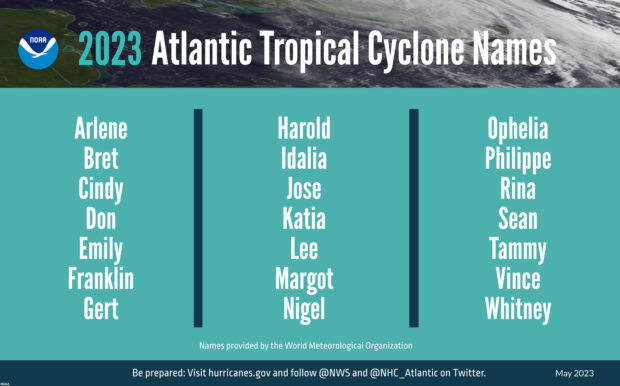

During a press conference today, the National Oceanic and Atmospheric Administration (NOAA) announced its forecast for the 2023 Atlantic Hurricane season.
The 20th anniversary of Hurricane Isabel, a category 2 storm at landfall that caused record storm surge and significant flooding in Baltimore as well as the 5th anniversary of Hurricane Florence, which caused $24.2 billion in damage, are grim reminders of the damage extreme weather can cause.
According to Rick Spinrad, Ph.D., NOAA administrator, there is a 40 percent chance of a near normal hurricane season this year.
Dr. Spinrad indicated the 2023 outlook called for 12 to 17 named storms (winds of 39 mph or higher). Of those, 5 to 9 could become hurricanes (winds of 74 mph or higher), including 1 to 4 major hurricanes (category 3, 4 or 5; with winds of 111 mph or higher). The agency has 70 percent confidence in these ranges.

There is a high likelihood for El Nino to develop this summer—something that could suppress hurricane activity in the Atlantic region.
With three back-to-back La Nina storm seasons and 14 named storms in 2022, Don Graves, deputy secretary of the U.S. Department of Commerce, explained how NOAA is committed to improving forecasts through technology advancements, satellite observations, and community outreach expansion.
Last year the storm names Fiona and Ian were retired due to the destruction and deaths each caused.
“Investments in preparedness protect properties and save lives,” he added.
Both the Department of Commerce and NOAA announced investments to build climate ready coastal communities.
Extreme weather has led to the importance of learning from each storm and applying that knowledge to future analysis, Graves said.
NOAA’s forecast track has improved by 40 percent since 2017.
The agency is rolling out a new hurricane model, the Hurricane Analysis and Forecast System, next month. It offers 10- 15 percent improvement over previous models.
The agency’s supercomputer capacity is set to be upgraded in July, offering a mind blowing 29 quadrillion calculations per second.
The tropical weather outlook has already been extended from five to seven days and its storm surge model has been upgraded, as well.
Additional days of preparedness can save lives and mitigate damage, he added.
As the upcoming season approaches, Graves recommended the public be prepared, heed warnings and stockpile supplies to ensure readiness.
Also in attendance during the hurricane announcement was Deanne Criswell, FEMA administrator. She explained how the agency successfully used geospatial technology to direct resources after Hurricane Ian.
She recommended the public, living in or near hurricane-affected areas, be prepared by knowing their risk, determining how they will receive information related to approaching storms, and by having an evacuation plan in place.
[inline-ad-1]